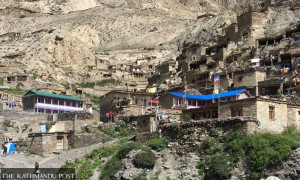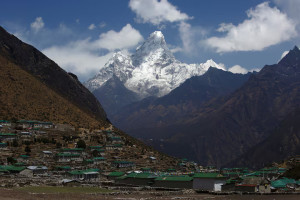National
Floodwaters wipe out Rs 8b worth of crops
Floodwaters have wiped out Rs 8.11 billion worth of crops as the country suffered record floods following torrential rain from August 11-14 that inundated huge tracts of land in 31 districts, the Ministry of Agricultural Development said on Wednesday.
Sangam Prasain
Floodwaters have wiped out Rs 8.11 billion worth of crops as the country suffered record floods following torrential rain from August 11-14 that inundated huge tracts of land in 31 districts, the Ministry of Agricultural Development said on Wednesday.
Government officials estimate further losses amounting to billions including livestock and private food stores swept away by the surging water. The deluge affected 31 districts, 19 of them severely.
“This is the first time that the entire country except Kapilvastu has been flooded at the same time,” said Rishi Ram Sharma, director general of the Department of Hydrology and Meteorology. “The rains started from the east and shifted to the west, covering the Central Region.”
The highest 24-hour rainfall of 516 mm was observed in Hetauda on Friday. Monsoon clouds dumped 496 mm of rain on Chitwan and 435 mm on Banke. “Banke was drenched with 99.8 mm of rain in one hour.”
The crop damage could cast a shadow on the economy that showed signs of recovery in the last fiscal year due to record food harvests. The World Bank had forecast Nepal’s economic growth rate at 7.5 percent in the last fiscal year on the back of a big jump in agricultural output due to a good monsoon, elimination of power cuts and higher government spending, among others.
The disaster, however, has put the brakes on growth. Government officials said that the impact of the disaster is likely to increase pressure on farmer incomes and inflation that had cooled to less than 5 percent.
The impact of reduced production is likely to swell the import bill for agricultural products that is close to touching the Rs 200 billion mark. Before the floods, the ministry had envisaged an increase in the paddy output to 5.4 million tonnes from the record production of 5.2 million tonnes in the last fiscal year.
“The floods have shattered growth prospects,” said Yogendra Kumar Karki, spokesperson for the ministry. “But we are confident that the paddy harvest will not be lower than last year’s level.” He added that paddy transplantation had been completed on 1.3 million hectares of paddy fields before the flood.
Paddy is planted on 1.5 million hectares. A drop in the paddy harvest will hit the economy hard as it accounts for 20 percent of the total agricultural output.
The farm sector’s contribution to the country’s gross domestic product (GDP) amounted to Rs 691.2 billion in the last fiscal year. This was around 29 percent of the GDP. The ministry’s statistics show that 270,406 hectares of standing crops of paddy, maize, pulses, banana and spices were damaged by the flood. Likewise, fishes on 2,224 hectares were swept away.
The paddy crop suffered the most with damage amounting to Rs 3.18 billion, followed by vegetables (Rs 2.96 billion), pulses (Rs 536 million), fishes (Rs 800 million), turmeric (Rs 340 million) and maize (Rs 241 million). “We are yet to calculate the loss of food stored by people in their homes, and the figure could be big,” said Karki.
Agriculture Minister Ram Krishna Yadav said that the government would be launching a relief package to help farmers. “It may be in the form of subsidies on seeds, fertilizers and agriculture machinery.”
The ministry has urged farmers to use paddy varieties that can tolerate submergence stress in order to minimize losses. It said that varieties like Hardinath 1 and 3, Radha 4 and Sukhha Dhan 1, 2, 3, 4, 5 and 6 can be sowed on paddy fields damaged by floods.
These seeds need to be kept in water for 36 to 48 hours for them to germinate. After that, they can be planted directly. These climate-smart seeds are available at local seed companies, state-owned National Seed Company and Nepal Agricultural Research Council, the ministry said.
“To protect plants from weeds, farmers need to apply Pendimethalin herbicide within two to four days of sowing,” the ministry said. It added that 50-millilitres of Pendimethalin mixed with 15 litres of water can be sprayed on a kattha of land.
The ministry said farmers who had transplanted Swarna Sub-1, Sawa Munsuli Sub-1 and Ciherang Sub 1 need not worry as these varieties can tolerate both drought and submergence stress. The plant has the ability to re-grow even after two weeks of submergence.
Meanwhile, the Ministry of Livestock Development reported that more than 62,000 chickens and an unknown number of livestock perished in the disaster.
“This is just a preliminary report. Due to transportation problems and waterlogged roads, our officials have not been able to collect the actual data,” said Shyam Poudel, spokesperson for the ministry. “The losses could amount to billions.”




 16.12°C Kathmandu
16.12°C Kathmandu















